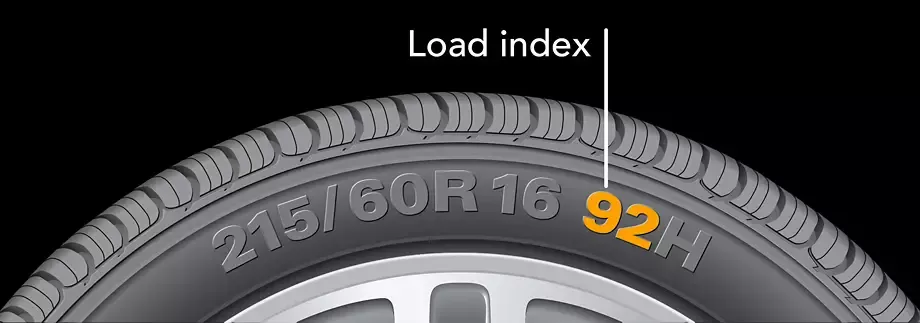Tire Load Index
The tire load index may not be a term familiar to all drivers, but it plays a crucial role in vehicle safety and performance. This index is a numerical code that signifies the maximum load a tire can safely support when properly inflated. Understanding and adhering to the tire load index is essential for maintaining the integrity of your vehicle's performance and ensuring safety on the road.

What is Tire Load Index
The tire load index indicates the tire's load carrying capacity when inflated to its maximum load sustaining air pressure. It is a vital piece of information that ensures you are using tires that can safely support your vehicle's weight, including passengers and cargo. The tire load index is typically a two or three-digit number. This number is not a direct measurement of pounds or kilograms but rather a value that corresponds to a specific weight capacity listed in a tire load index chart.
Dual Tire Load Index
A dual tire load index is a critical specification found on tires designed for vehicles capable of carrying heavy loads, such as commercial trucks, light trucks, vans, and some recreational vehicles. This specification indicates the tire's maximum load capacity under two distinct conditions: when used as a single tire and when used in pairs (dual configuration). Presented as two numbers separated by a slash (115/113), the first number reflects the maximum load that one tire can support when it's used individually, while the second number represents the maximum load per tire when used in a dual tire setup, acknowledging the different load-bearing capabilities and distribution in these scenarios. For example, a dual load index of 115/113 signifies that the tire can carry up to 1215 kilograms (approximately 2679 pounds) when mounted in a single configuration, and 1150 kilograms (approximately 2535 pounds) when used in a dual configuration. This differentiation is crucial for maintaining vehicle safety and performance, ensuring that tires are not overloaded beyond their designed capacity, which can lead to tire failure and potentially hazardous driving conditions.
Why is Tire Load Index Important
The tire load index is crucial for several reasons, all of which contribute to the safety, performance, and longevity of both your tires and vehicle. The most critical aspect of the tire load index is safety. A tire with a load index that is too low for the vehicle may not be able to support the weight of the vehicle, especially when it's fully loaded with passengers or cargo. This can lead to tire failure, which includes the risk of blowouts, particularly at high speeds or under strenuous driving conditions. Proper tire load index also ensures that your vehicle handles and performs as it should. Tires that are not suited to the vehicle's weight can negatively impact handling, braking, and overall stability. This can make the vehicle less responsive and potentially more difficult to control, especially in emergency situations. In additions, using tires with the appropriate load index can significantly extend their life. Tires that are overburdened (carrying more weight than they're designed for) will wear out faster. This premature wear can manifest as uneven tread wear, which in turn can lead to a need for more frequent tire replacements. Futhermore, in some jurisdictions, using tires that do not meet the manufacturer's specified load index can have legal ramifications and might affect insurance claims. If an accident were to occur and it's found that the tires were not appropriate for the vehicle, it could lead to denied insurance claims or even legal penalties. Finally, tires with the correct load index for the vehicle contribute to a smoother and more comfortable ride. Tires that are not capable of supporting the vehicle's weight may lead to a rough, uncomfortable ride, with increased vibration and noise.
How to Find Tire Load Index
You can find the tire load index on the tire's sidewall, usually following the size designation. It appears as a number within the tire's service description, which also includes tire speed rating. Understanding how to read this number is critical for choosing the right tire for your vehicle and driving needs. For example, in a tire marked 215/60R16 92H, the 92 indicates the load index.

When replacing your tires, make sure new ones have the same load index or higher to adequately support your vehicle's weight.
If you are in doubt about what the load index should be for your vehicle, consult the vehicle's owner manual or the placard on the driver's side door jamb for the recommended tire size and tire load index.
Tire Load Index Calculator
To find out the maximum load capacity your tire can carry, enter its tire load index:
Tire Load Index Chart
Below you will find all tire load indexes with a corresponding maximum load capacity per each tire.
| Load Index | Max Load Capacity | |
|---|---|---|
| 1 | 102 lbs | 46 kg |
| 2 | 105 lbs | 48 kg |
| 3 | 107 lbs | 49 kg |
| 4 | 110 lbs | 50 kg |
| 5 | 114 lbs | 52 kg |
| 6 | 117 lbs | 53 kg |
| 7 | 120 lbs | 54 kg |
| 8 | 123 lbs | 56 kg |
| 9 | 128 lbs | 58 kg |
| 10 | 132 lbs | 60 kg |
All listed guides, data and/or calculations are for informational purposes only. TireSizes.com does not warrant or make any representations regarding the accuracy of or the results of the use of this information.